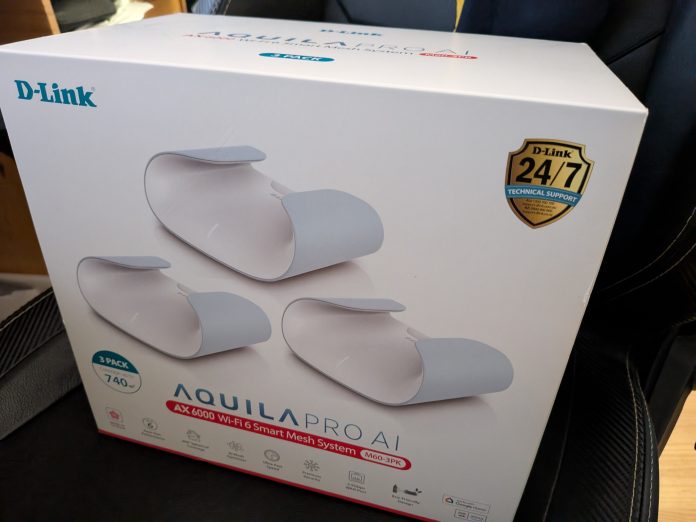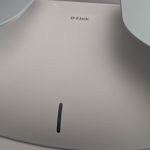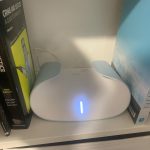The D-Link Aquila Pro AI M60 AX6000 Mesh Wi-Fi system stands out as a genuinely affordable, high-performance solution for users requiring reliable connectivity across larger spaces. This model leverages Wi-Fi 6 technology, enabling combined speeds of up to 6Gbps. It is built for demanding tasks such as 4K streaming, competitive online gaming, and seamless connectivity for smart home devices and storage. Its dual-band system features a 2.4GHz band capable of up to 1.2Gbps and a 5GHz band delivering up to 4.8Gbps, ensuring faster data transfers and reduced network congestion even in densely connected environments.
Hardware and Connectivity
The M60 comes equipped with a 2.5Gbps WAN port, ideal for high-speed broadband connections, and four Gigabit LAN ports, providing flexibility for wired devices such as gaming consoles, smart TVs, or NAS (Network Attached Storage) systems. However, the single Multi-Gig port is dedicated solely to WAN usage, limiting local multi-gigabit wired connections, which might be a concern for advanced users managing several high-speed wired devices simultaneously.
The M60 is part of a scalable mesh system, allowing multiple nodes to work together to deliver consistent, high-speed Wi-Fi coverage throughout your home or office. Each node delivers seamless roaming, ensuring devices automatically switch to the strongest signal as you move around; eliminating pesky dead zones and weak connections, particularly in multi-story homes, or long (front to rear – often occurring in new builds on subdivided blocks) or expansive spaces.
Each node supports wireless backhaul, allowing them to communicate with one another wirelessly. For environments with higher interference or more demanding performance needs, the system also supports wired backhaul — Something I recommend after my excellent experience going from a horrible, to highly functional setup — using Ethernet. This flexibility ensures the mesh network maintains maximum speed and reliability regardless of layout or interference.
All of this is wrapped into nodes that have a sleek, manta ray-inspired design, blending well with more modern interior designs. They are constructed using post-consumer recycled materials, and the packaging — save a few small pieces of plastic — is recyclable, highlighting D-Link’s commitment to environmentally conscious practices.
Extra features you might not notice
There are plenty of features that are common, but people don’t necessarily know about, recognise or understand how they’re of benefit to the user experience. At the end of it all, these features are designed to give you better speed and more reliable connectivity.
For the D-Link Aquila Pro, this includes three key features that I believe had the most impact on my user experience:
- Beamforming Technology: Enhances signal strength by directing Wi-Fi signals to connected devices rather than broadcasting in all directions.
- MU-MIMO: Allows multiple devices to communicate simultaneously with the router, reducing wait times and improving efficiency for environments with multiple users.
- OFDMA (Orthogonal Frequency Division Multiple Access): Increases the efficiency of data transfers — covered in more detail here — by breaking Wi-Fi channels into smaller sub-channels, improving performance when multiple devices are connected.
The user experience: Setup to streaming
The system is managed through the Aquila Pro AI app, which simplifies the setup and offers a range of network management tools. Users can configure advanced parental controls, schedule device access, and monitor network activity with ease.
However, the app had a couple of bugs and omissions that were frustrating like manual firmware updates occasionally failing, not all features being available in the app (you can complete more complex tasks in the web interface), and it’s not outstanding when it comes to ease of navigation but it’s certainly going to meet most users needs. While they’re not deal breakers for most users, these are things well worth mentioning.
The setup process is really simple in that you install the app, scan the QR code and follow the bouncing ball through the setup process. There are some nuances to different ISP setups, so if you’re having issues, you should consult your ISP help pages or give their helpdesk a call.
Pairing second and third nodes in your mesh system is no more complicated than this either; just follow the on-screen instructions that guide you to pair them. Learning from experience on a previous mesh system review, I highly recommend plugging all of your units in where they have a physical line of site to each other; this speeds up the process. You can then move them to their final destination within your home to maximise your coverage.
At home I’ve got some pretty serious hardware in place, so this went on its own subnet and during my two months of testing, I only noticed a few times where the performance wasn’t quite keeping up with the hardware I normally run. I can confidently say, though, that short of users who are moving large data files around regularly and track their data speeds, you’re not going to notice the difference. But I’m also confident in saying if you’re buying this system – it will be a significant upgrade from whatever you’re already running, so you will be more than happy with your investment.
Conclusion: Who is the Aquila Pro AI M60 for?
The D-Link Aquila Pro AI M60 AX6000 is a high-speed, feature-rich mesh system designed for home users with demanding connectivity needs; whether that’s coverage challenges, connectivity speed or just the number of devices (I’m looking at my kids right now…) all trying to access data at the same time.
In short, particularly for the dollars, its impressive specifications and flexible mesh node connectivity make it a strong contender for large homes or even small to medium offices. While the reliance on a single 2.5Gbps WAN port and app-based management may pose minor drawbacks, its robust wireless performance, sustainable design, and ability to scale make it an attractive choice for modern environments.
You can pick up the M60 3 pack at D-Link online, Officeworks, JB Hi-Fi, Amazon or a host of other online retailers for — at the time of publishing this review — AU$549.00













